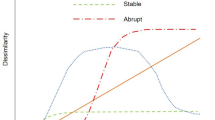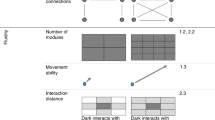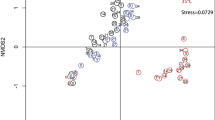Abstract
Ecosystems can experience catastrophic transitions to alternative states, yet recent results have suggested that slowing down in rates of recovery after a perturbation may provide advance warning that a critical transition is approaching. Perturbation experiments with microbial populations have supported this hypothesis under controlled laboratory conditions, but evidence from natural ecosystems remains rare. Here, we manipulated rocky intertidal canopy algae to test the hypothesis that the spatial scale at which the system recovers from a perturbation in space should increase as the system approaches the tipping point, marking the transition from a canopy-dominated to a turf-dominated state. Empirical estimates of recovery length, a recently proposed spatial indicator of an approaching tipping point, were obtained by comparing the spatial scale at which algal turfs propagated into canopy-degraded regions with decreasing canopy cover. We show that recovery length increased along the gradient in canopy degradation, providing field-based evidence of spatial signatures of critical slowing down in natural conditions.
This is a preview of subscription content, access via your institution
Access options
Access Nature and 54 other Nature Portfolio journals
Get Nature+, our best-value online-access subscription
$29.99 / 30 days
cancel any time
Subscribe to this journal
Receive 12 digital issues and online access to articles
$119.00 per year
only $9.92 per issue
Buy this article
- Purchase on Springer Link
- Instant access to full article PDF
Prices may be subject to local taxes which are calculated during checkout





Similar content being viewed by others
References
Scheffer, M., Carpenter, S., Foley, J. A., Folke, C. & Walker, B. Catastrophic shifts in ecosystems. Nature 413, 591–596 (2001).
Hughes, T. P. Catastrophes, phase shifts, and large-scale degradation of a Caribbean coral reef. Science 265, 1547–1551 (1994).
Staver, A. C., Archibald, S. & Levin, S. A. The global extent and determinants of savanna and forest as alternative biome states. Science 334, 230–232 (2011).
Wissel, C. A universal law of the characteristic return time near thresholds. Oecologia 65, 101–107 (1984).
Scheffer, M. et al. Anticipating critical transitions. Science 338, 344–348 (2012).
Scheffer, M. et al. Early-warning signals for critical transitions. Nature 461, 53–59 (2009).
van Nes, E. H. & Scheffer, M. Slow recovery from perturbations as a generic indicator of a nearby catastrophic shift. Am. Nat. 169, 738–747 (2007).
Dai, L., Vorselen, D., Korolev, K. S. & Gore, J. Generic indicators for loss of resilience before a tipping point leading to population collapse. Science 336, 1175–1177 (2012).
Veraart, A. J. et al. Recovery rates reflect distance to a tipping point in a living system. Nature 481, 357–359 (2012).
Benedetti-Cecchi, L., Tamburello, L., Maggi, E. & Bulleri, F. Experimental perturbations modify the performance of early warning indicators of regime shift. Curr. Biol. 25, 1867–1872 (2015).
Carpenter, S. R. et al. Early warnings of regime shifts: a whole-ecosystem experiment. Science 332, 1079–1082 (2011).
Cline, T. J. et al. Early warnings of regime shifts: evaluation of spatial indicators from a whole-ecosystem experiment. Ecosphere 5, 1–13 (2014).
Drake, J. M. & Griffen, B. D. Early warning signals of extinction in deteriorating environments. Nature 467, 456–459 (2010).
Dakos, V. et al. Slowing down as an early warning signal for abrupt climate change. Proc. Natl Acad. Sci. USA 105, 14308–14312 (2008).
Lade, S. J. & Gross, T. Early warning signals for critical transitions: a generalized modeling approach. PLoS Comput. Biol. 8, e1002360 (2012).
Kéfi, S., Dakos, V., Scheffer, M., Van Nes, E. H. & Rietkerk, M. Early warning signals also precede non-catastrophic transitions. Oikos 122, 641–648 (2013).
Boettiger, C. & Hastings, A. Early warning signals and the prosecutor’s fallacy. Proc. R. Soc. B 279, 4734–4739 (2012).
Dakos, V. et al. Methods for detecting early warnings of critical transitions in time series illustrated using simulated ecological data. PLoS ONE 7, e41010 (2012).
Bestelmeyer, B. T. et al. Analysis of abrupt transitions in ecological systems. Ecosphere 2, 1–26 (2011).
Lenton, T. M., Livina, V. N., Dakos, V., van Nes, E. H. & Scheffer, M. Early warning of climate tipping points from critical slowing down: comparing methods to improve robustness. Phil. Trans. R. Soc. A 370, 1185–1204 (2012).
Kefi, S. et al. Early warning signals of ecological transitions: methods for spatial patterns. PLoS ONE 9, e92097 (2014).
Dakos, V., van Nes, E. H., Donangelo, R., Fort, H. & Scheffer, M. Spatial correlation as leading indicator of catastrophic shifts. Theor. Ecol. 3, 163–174 (2010).
Guttal, V. & Jayaprakash, C. Spatial variance and spatial skewness: leading indicators of regime shifts in spatial ecological systems. Theor. Ecol. 2, 3–12 (2000).
Streeter, R. & Dugmore, A. J. Anticipating land surface change. Proc. Natl Acad. Sci. USA 110, 5779–5784 (2013).
Litzow, M. A., Urban, J. D. & Laurel, B. J. Increased spatial variance accompanies reorganization of two continental shelf ecosystems. Ecol. Appl. 18, 1331–1337 (2008).
Carpenter, S. R. & Brock, W. A. Early warnings of regime shifts in spatial dynamics using the discrete Fourier transform. Ecosphere 1, 1–15 (2010).
Kefi, S. et al. Spatial vegetation patterns and imminent desertification in Mediterranean arid ecosystems. Nature 449, 213–217 (2007).
Kefi, S. et al. Robust scaling in ecosystems and the meltdown of patch size distributions before extinction. Ecol. Lett. 14, 29–35 (2011).
Rietkerk, M., Dekker, S. C., de Ruiter, P. C. & van de Koppel, J. Self-organized patchiness and catastrophic shifts in ecosystems. Science 305, 1926–1929 (2004).
Dakos, V., Kefi, S., Rietkerk, M., van Nes, E. H. & Scheffer, M. Slowing down in spatially patterned ecosystems at the brink of collapse. Am. Nat. 177, E153–E166 (2011).
Dai, L., Korolev, K. S. & Gore, J. Slower recovery in space before collapse of connected populations. Nature 496, 355–358 (2013).
Dai, L., Korolev, K. S. & Gore, J. Relation between stability and resilience determines the performance of early warning signals under different environmental drivers. Proc. Natl Acad. Sci. USA 112, 10056–10061 (2015).
Scheffer, M., Carpenter, S. R., Dakos, V. & van Nes, E. H. Generic indicators of ecological resilience: inferring the chance of a critical transition. Annu. Rev. Ecol. Evol. Syst. 46, 145–167 (2015).
Livina, V. N., Kwasniok, F. & Lenton, T. M. Potential analysis reveals changing number of climate states during the last 60 kyr. Clim. Past 6, 77–82 (2010).
Konar, B. & Estes, J. A. The stability of boundary regions between kelp beds and deforested areas. Ecology 84, 174–185 (2003).
Robles, C. D., Garza, C., Desharnais, R. A. & Donahue, M. J. Landscape patterns in boundary intensity: a case study of mussel beds. Landscape Ecol. 25, 745–759 (2010).
Scheffer, M. et al. Vegetated areas with clear water in turbid shallow lakes. Aquat. Bot. 49, 193–196 (1994).
Silliman, B. R., van de Koppel, J., Bertness, M. D., Stanton, L. E. & Mendelssohn, I. A. Drought, snails, and large-scale die-off of southern U.S. salt marshes. Science 310, 1803–1806 (2005).
Da Silveira Lobo Sternberg, L. Savanna–forest hysteresis in the tropics. Global Ecol. Biogeogr. 10, 369–378 (2001).
Batt, R. D., Carpenter, S. R., Cole, J. J., Pace, M. L. & Johnson, R. A. Changes in ecosystem resilience detected in automated measures of ecosystem metabolism during a whole-lake manipulation. Proc. Natl Acad. Sci. USA 110, 17398–17403 (2013).
Rietkerk, M. & van de Koppel, J. Regular pattern formation in real ecosystems. Trends Ecol. Evol. 23, 169–175 (2008).
Barbier, N., Couteron, P., Lejoly, J., Deblauwe, V. & Lejeune, O. Self-organized vegetation patterning as a fingerprint of climate and human impact on semi-arid ecosystems. J. Ecol. 94, 537–547 (2006).
Steneck, R. S. et al. Kelp forest ecosystems: biodiversity, stability, resilience and future. Environ. Conserv. 29, 436–459 (2002).
Benedetti-Cecchi, L. et al. Predicting the consequences of anthropogenic disturbance: large-scale effects of loss of canopy algae on rocky shores. Mar. Ecol. Prog. Ser. 214, 137–150 (2001).
Connell, S. D. et al. Recovering a lost baseline: missing kelp forests from a metropolitan coast. Mar. Ecol. Prog. Ser. 360, 63–72 (2008).
Beck, M. & Airoldi, L. Loss, status and trends for coastal marine habitats of Europe. Oceanogr. Mar. Biol. 45, 345–405 (2007).
Pace, M. L., Carpenter, S. R. & Cole, J. J. With and without warning: managing ecosystems in a changing world. Front. Ecol. Environ. 13, 460–467 (2015).
Lenton, T. M. & Williams, H. T. On the origin of planetary-scale tipping points. Trends Ecol. Evol. 28, 380–382 (2013).
Brook, B. W., Ellis, E. C., Perring, M. P., Mackay, A. W. & Blomqvist, L. Does the terrestrial biosphere have planetary tipping points? Trends Ecol. Evol. 28, 396–401 (2013).
Worm, B. & Lotze, H. K. Effects of eutrophication, grazing, and algal blooms on rocky shores. Limnol. Oceanogr. 51, 569–579 (2006).
Benedetti-Cecchi, L. et al. Linking patterns and processes across scales: the application of scale-transition theory to algal dynamics on rocky shores. J. Exp. Biol. 215, 977–985 (2012).
Tamburello, L., Bulleri, F., Bertocci, I., Maggi, E. & Benedetti-Cecchi, L. Reddened seascapes: experimentally induced shifts in 1/fspectra of spatial variability in rocky intertidal assemblages. Ecology 94, 1102–1111 (2013).
Connell, S. D., Foster, M. S. & Airoldi, L. What are algal turfs? Towards a better description of turfs. Mar. Ecol. Prog. Ser. 495, 299–307 (2014).
Lahti, L., Salojärvi, J., Salonen, A., Scheffer, M. & de Vos, W. M. Tipping elements in the human intestinal ecosystem. Nat. Commun. 5, 4344 (2014).
Bolker, B. M. Ecological Models and Data in R. (Princeton Univ. Press, 2008).
Hijmans, R. J. & van Etten, J. raster: geographic analysis and modeling with raster data, R package version 2.0-12. (2012).
Genz, A. & Bretz, F. Computation of Multivariate Normal and t Probabilities . (Springer Berlin Heidelberg, 2009).
Soetaert, K., Cash, J. & Mazzia, F. Solving Differential Equations in R. (Springer Berlin Heidelberg, 2012).
Soetaert, K. & Meysman, F. Reactive transport in aquatic ecosystems: rapid model prototyping in the open source software R. Environ. Model. Softw. 32, 49–60 (2012).
Acknowledgements
We thank E. Maggi, F. Bulleri, C. Ravaglioli and L. Tamburello for field and technical assistance, A. Rattray for useful comments on the manuscript, A. Perez-Escudero for helping to develop the model, R. Casagrandi and L. Mari for their feedback. The authors acknowledge financial support from University of Pisa through the PRA (PRA_2015_055) and MISTI projects, the latter in collaboration with MIT. J.G. also acknowledges support from an NIH New Innovator Award (DP2 AG044279).
Author information
Authors and Affiliations
Contributions
L.R. and L.B.-C. designed the study. L.R. did the analyses and wrote the first draft of the manuscript. M.D.B., L.D. and J.G. assisted with the analysis. L.R., M.D.B and L.B.-C. performed the experiment. All authors contributed to interpreting the results and commented on the manuscript.
Corresponding author
Ethics declarations
Competing interests
The authors declare no competing financial interest.
Supplementary information
Supplementary Information
Supplementary Methods; Supplementary Figures 1–7; Supplementary Table 1 (PDF 3240 kb)
Rights and permissions
About this article
Cite this article
Rindi, L., Bello, M., Dai, L. et al. Direct observation of increasing recovery length before collapse of a marine benthic ecosystem. Nat Ecol Evol 1, 0153 (2017). https://doi.org/10.1038/s41559-017-0153
Received:
Accepted:
Published:
DOI: https://doi.org/10.1038/s41559-017-0153
This article is cited by
-
Highly restricted dispersal in habitat-forming seaweed may impede natural recovery of disturbed populations
Scientific Reports (2021)
-
Impairment of microbial and meiofaunal ecosystem functions linked to algal forest loss
Scientific Reports (2020)
-
Experimental analyses of diversity partitioning in southern hemisphere algal communities
Oecologia (2019)
-
Rate of recovery from perturbations as a means to forecast future stability of living systems
Scientific Reports (2018)
-
Choosing the future of Antarctica
Nature (2018)



